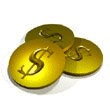 |
by Robert V. Rowe |
 |
|
It is this fanís opinion that most people, when given a choice, will tend to take the easy way out, and this certainly applies to many horse players. If thatís a valid observation it would follow that obvious favorites should be looked on with a jaundiced eye. Handicapping profits are not achieved by automatically going along with the crowd. It is the obscure (but valid) factors that one spots that will probably prove to be the ones that produced a profit. An illustration of a less-than-obvious factor; assume Horse A was claimed last out by a competent trainer from a conditioner whose record leaves much to be desired. It would then be reasonable to expect Horse A to show improvement. This could be a legitimate but a not-so-obvious reason for placing a wager. Expressed otherwise, weíre suggesting, for example, that horses with obvious form, such as having won by five or more lengths, or moved down the claiming ladder from $50, 000 to $35,000, should not necessarily be regarded as goodthings despite what the tote board says. The problem is that even if they are legitimate favorites, the chances are great that they will be over-bet; using the term "over-bet" to mean that, as a group, such horses will not win a sufficient number of races to warrant their low odds. Conversely, if a favorite (or any other choice) seems to be getting more play than its recent form would warrant, thatís the time to bring out the magnifying glass and look very close. Invariably thereís a good reason the horse is receiving relatively heavy play. Donít, however, bet this type unless you can find valid reasons to account for the money coming in on the horse. The reasons may prove obscure but this very "obscurity" is what creates so-called "overlays."
THE NEW YORK TRIP Your scribe mentioned in a previous column that he was going to New York to visit Aqueduct, and to note whatever changes had taken place after his having been away almost four years. Well, he visited; stayed two days, and would love to brag about how well he did. This, however, was not the case. He made five bets (four exactas and one to win) and came up a blank. However, the trip served to fortify his conviction, and oft repeated contention, that the race track is not the place to socialize, that is if one is serious about winning. I found it impossible to analyze past performances, watch the changing odds, and study potential exacta payoffs while still responding courteously to the many old friends and acquaintances who came over to shake hands and inquire as to how I was doing. Productive handicapping is an art that requires 100% concentration. Look for HH NO. 25 to appear on or about March 15th.
|

